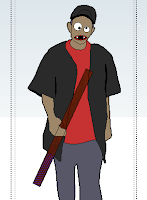This beautiful tiling is one of the subjects (and the cover model!) of one of my GeomeTricks Aperiodic Patterns books:
Well, guess who found this video and got in touch with me? The very person who discovered this tile: Michael Hirschhorn! Call me a geometry geek, but that would be like Justin Bieber emailing my 8-year old daughter :-)
We've already had lots of back-and-forths, but here's a snippet of what he wrote about the background of how he got to this tiling:
Back in the early 1970's, the Faculty of Science here [in Sydney, Australia] set up a program by which kids from (what we call) high school in their second-last year (so aged 16 or 17 or so) were invited to apply to spend a week near the end of their school year (November) involved in a variety of projects (in Physics, Chemistry, Math, Biological Science, .. ) in groups of about six, led by an academic. (About 120 students were involved each year.) In 1974, Professor George Szekeres led a group on the (very optimistic) task of finding all pentagons that tile the plane (a problem, incidentally, which is not known to be completely solved even today.) I was a young and junior member of staff (27), and looked in at what they were doing. They very quickly (within a day or two) restricted their goal to finding all equilateral, convex pentagons that tile the plane.
The group found a cosine rule that holds in an equilateral convex pentagon. At about the same time, I noticed that in every tiling we knew, the angles came together as follows A+B+C=360 degrees twice for every vertex where 2D+2E=360 degrees. (Each angle occurs twice in such an arrangement, and 2A+2B+2C+2D+2E=1080 degrees =3 times 360 degrees.) I suggested that there may be a tiling in which 2A+B+C=360 degrees, B+2D=360 degrees and C+2E=360 degrees. The Professor took home these relations and our cosine rule, and with considerable amount of work (by hand) found the solution, A=60, B=160, C=80, D=100, E=140 degrees. He brought in his solution the next day, we cut out many such pentagons, and discovered it really did tile the way I proposed! Four such pentagons together form shapes like little penguins that march across the plane in rows, and the rows fill the plane. And that is essentially where our discoveries ended. The students then wrote up the week's work, and presented it to a large audience on the Friday night. After that, on my way home in the car, I had the thought, "What happens if we put six of the 60 degree angles together?" And by the time I reached home, I suspected that I could continue the tiling to cover the plane. So I got out my 20 or so pentagons, and, lo and behold, it worked!
Mike also showed me a Hirschhorn tessellation that I hadn't covered in my book:
And he also described an irregular, equilateral pentagon tiling that tiles just like the 9-sided "Bent Wedge" covered in the same book:
Even if you aren't into geometry, you gotta admit that these are some pretty pictures!
Anyone can design anything in 3D! http://www.3dvinci.net/













